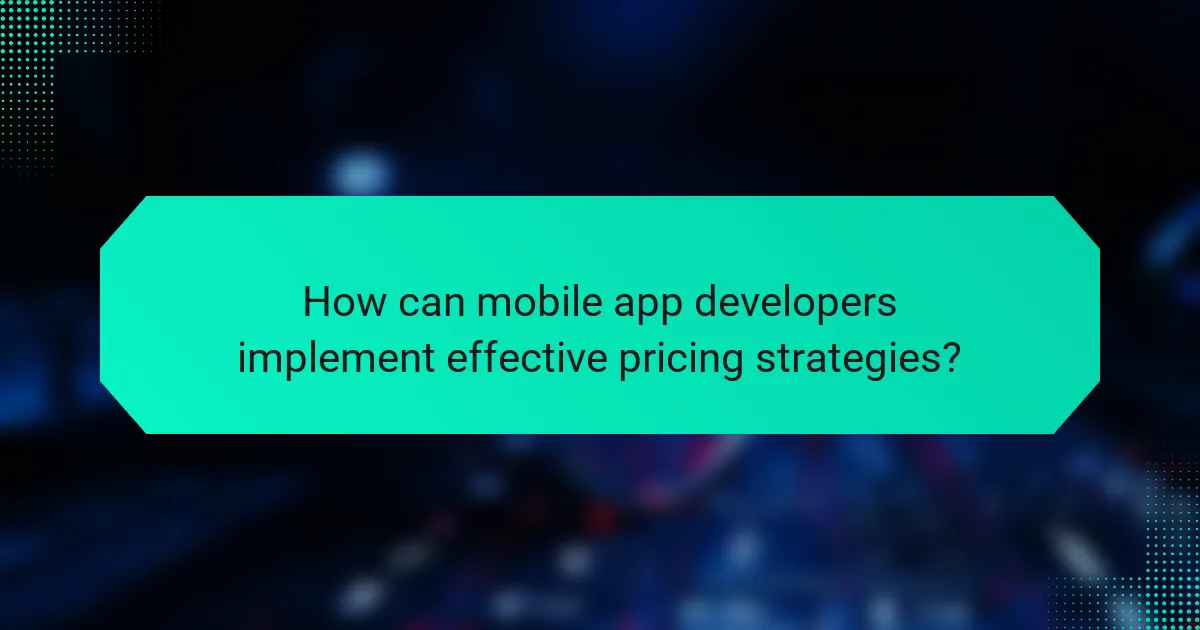Mobile app pricing strategies are critical for developers aiming to maximize revenue and user retention. Best practices include understanding target markets, analyzing competitor pricing models, and implementing flexible pricing options such as freemium, subscription, and one-time purchase models. Research indicates that 70% of consumers favor free apps with in-app purchases, highlighting the importance of allowing users to experience the app before committing financially. Additionally, employing tiered pricing and psychological pricing techniques can enhance perceived value and cater to diverse user needs. Regular evaluation of user feedback and market trends is essential for refining these strategies and remaining competitive in the app marketplace.

What are the best practices for mobile app pricing strategies?
The best practices for mobile app pricing strategies include understanding your target market, analyzing competitors, and offering flexible pricing models. Research indicates that 70% of consumers prefer free apps with in-app purchases. This method allows users to try the app before making a financial commitment. Implementing tiered pricing can cater to different user needs and budgets. A study by App Annie shows that apps with multiple pricing tiers see a 30% increase in revenue. Regularly evaluating user feedback helps refine pricing strategies. Additionally, using psychological pricing techniques can enhance perceived value. Pricing should also consider market trends and user behavior to remain competitive.
How do competitive analysis and market trends influence pricing strategies?
Competitive analysis and market trends significantly influence pricing strategies by providing insights into competitor pricing and consumer behavior. Competitive analysis allows businesses to understand how similar products are priced in the market. This knowledge helps companies position their own prices competitively to attract customers. Market trends reveal shifts in consumer preferences and demand, impacting pricing decisions. For instance, if a trend indicates rising demand for a particular feature, a company may increase prices to reflect its added value. According to a study by McKinsey, 70% of companies that monitor market trends effectively adjust their pricing strategies accordingly. This alignment with market dynamics ensures sustainable profitability and market relevance.
What key factors should be considered in competitive analysis?
Key factors in competitive analysis include market positioning, pricing strategies, and feature comparison. Market positioning helps identify competitors’ strengths and weaknesses. Pricing strategies reveal how competitors set their app prices. Feature comparison allows for understanding what functionalities are offered. Additionally, user reviews provide insights into customer satisfaction. Analyzing marketing tactics shows how competitors attract users. Monitoring updates and changes in competitors’ apps can indicate trends. Finally, assessing target demographics helps tailor strategies effectively. These factors collectively inform strategic decisions in mobile app pricing.
How can market trends impact pricing decisions?
Market trends significantly impact pricing decisions by influencing consumer demand and competitive positioning. When demand for a product increases, businesses may raise prices to maximize revenue. Conversely, if market trends indicate a decrease in demand, companies might lower prices to attract customers.
Additionally, competitors’ pricing strategies often shift in response to market trends. For instance, if a competitor lowers their prices, others may follow suit to maintain market share. Historical data shows that during economic downturns, many companies adjust their prices to remain competitive and retain customers.
Furthermore, emerging technologies or shifts in consumer preferences can lead to new pricing models. For example, the rise of subscription services has changed how apps are priced, reflecting consumer willingness to pay for ongoing access rather than one-time purchases.
Overall, market trends serve as a critical indicator for businesses to adjust their pricing strategies effectively.
Why is user perception important in mobile app pricing?
User perception is crucial in mobile app pricing because it directly influences purchasing decisions. Users often associate price with quality. A higher price may signal superior features or reliability. Conversely, a low price can lead to doubts about an app’s value. Research indicates that 70% of consumers consider price as a key factor in app selection. Understanding user perception helps developers set competitive prices. This alignment can enhance user satisfaction and retention. Ultimately, effective pricing based on user perception can drive higher revenue.
How does user perception affect pricing strategy effectiveness?
User perception significantly impacts pricing strategy effectiveness. When users perceive a price as fair, they are more likely to purchase. Conversely, if users view a price as too high, they may abandon their purchase. Research shows that perceived value often correlates with willingness to pay. For instance, a study by Grewal et al. (2011) found that consumer perceptions of quality directly influence their price sensitivity. Additionally, positive brand perception can justify higher pricing. Therefore, aligning pricing with user perception is crucial for maximizing sales and profitability.
What methods can be used to gauge user perception?
Surveys and questionnaires are effective methods to gauge user perception. They allow direct feedback from users regarding their experiences and opinions. Focus groups provide qualitative insights through guided discussions among selected users. A/B testing compares different app pricing strategies to see which resonates better with users. Analytics tools track user behavior and preferences within the app. Social media monitoring captures user sentiments and trends in real-time. User reviews and ratings on app stores reflect overall satisfaction and perception. These methods collectively offer a comprehensive understanding of user perception.

What are the different types of mobile app pricing models?
The different types of mobile app pricing models include free, freemium, one-time purchase, subscription, and advertising-based models. Free apps do not charge users but may include ads. Freemium apps offer basic features for free while charging for premium features. One-time purchase apps require a single upfront payment for full access. Subscription models charge users periodically for ongoing access to the app. Advertising-based models monetize through ad placements within the app. Each model caters to different user preferences and market demands, influencing overall revenue potential.
How do free, freemium, and paid models differ?
Free models offer users access without any cost. Users can download and use the app entirely for free. However, these apps often rely on ads or limited features to generate revenue. Freemium models provide a basic version for free. Users can access premium features through in-app purchases. This model allows users to try the app before committing financially. Paid models require an upfront payment to download the app. Users gain full access to all features without ads. Each model caters to different user preferences and monetization strategies.
What are the benefits and drawbacks of each pricing model?
There are several pricing models for mobile apps, each with distinct benefits and drawbacks. The freemium model allows users to access basic features for free, increasing user acquisition. However, it may lead to low conversion rates for premium upgrades. Subscription models provide steady revenue and enhance user retention, but they can deter users due to ongoing costs. One-time purchase models offer immediate revenue but limit long-term engagement and updates. Ad-supported models generate revenue through advertisements, yet they can disrupt user experience and lead to app abandonment. Each model’s effectiveness varies based on market trends and user preferences, highlighting the importance of competitive analysis in pricing strategy.
How do user demographics influence the choice of pricing model?
User demographics significantly influence the choice of pricing model for mobile apps. Different age groups exhibit varying spending habits. Younger users often prefer freemium models due to limited disposable income. In contrast, older demographics may favor subscription models, valuing ongoing services and features. Geographic location also plays a role; users in developed markets may accept higher prices than those in emerging markets. Gender differences can influence preferences for certain app features, impacting pricing strategies. Research shows that 60% of users aged 18-24 prefer free apps, while 55% of users over 45 are willing to pay for premium features. Understanding these demographic nuances allows developers to tailor pricing strategies effectively.
What role does subscription pricing play in mobile apps?
Subscription pricing plays a crucial role in mobile apps by providing a consistent revenue stream. This model allows developers to monetize their apps continuously rather than relying solely on one-time purchases. Subscription pricing encourages user retention, as users are more likely to engage with regularly updated content. According to a report by Sensor Tower, apps utilizing subscription models grew 30% in revenue in 2020. This growth indicates a strong user preference for ongoing access to services. Additionally, subscription pricing often leads to higher lifetime value for customers compared to traditional purchase models.
How can subscription pricing enhance user retention?
Subscription pricing enhances user retention by providing consistent value and convenience. Users appreciate the predictability of costs associated with subscriptions. This model fosters ongoing engagement with the app. Regular updates and new content can be delivered easily under a subscription framework. Additionally, subscription pricing often leads to a sense of commitment from users. They are more likely to continue using a service they have invested in. Research shows that subscription models can increase user lifetime value by up to 300%. This statistic underscores the potential of subscriptions to secure long-term user loyalty.
What factors should be considered when setting subscription rates?
When setting subscription rates, market demand is a critical factor. Understanding user willingness to pay helps in pricing effectively. Competitor pricing also influences subscription rates. Analyzing similar offerings in the market provides context. Cost structure is essential as well. This includes development, maintenance, and marketing expenses. Customer lifetime value should be considered to ensure profitability. User engagement metrics can indicate how much users value the service. Economic conditions may affect disposable income and spending behavior. These factors collectively inform optimal subscription pricing strategies.

How can mobile app developers implement effective pricing strategies?
Mobile app developers can implement effective pricing strategies by analyzing market trends and user preferences. They should conduct competitive analysis to understand pricing models used by similar apps. This involves researching direct competitors and identifying their pricing tiers. Developers can also gather user feedback to determine perceived value and willingness to pay. Offering multiple pricing options, such as freemium and subscription models, can cater to diverse user segments. Implementing A/B testing on pricing can help identify the most effective price points. According to a 2021 study by Statista, apps with flexible pricing strategies see higher user retention rates.
What are the key steps to develop a successful pricing strategy?
Define your target market. Understand the demographics and preferences of potential users. Conduct competitor analysis. Analyze pricing models used by similar apps. Determine your app’s unique value proposition. Identify what differentiates your app from competitors. Choose a pricing model. Options include freemium, subscription, or one-time purchase. Test your pricing strategy. Use A/B testing to gauge user response. Monitor and adjust pricing based on performance. Regularly review market trends and user feedback. Adapt your strategy as necessary to remain competitive.
How should developers analyze competitors before setting prices?
Developers should analyze competitors by examining their pricing models, features, and user reviews. This involves researching similar apps in the same category. Developers can utilize tools like App Annie or Sensor Tower for market insights. They should compare pricing tiers and promotional strategies of competitors. Analyzing user feedback helps identify perceived value and areas for improvement. Developers should also consider the pricing strategies of top competitors in their niche. This competitive analysis informs pricing decisions and enhances market positioning. Understanding competitor performance can lead to more informed pricing strategies.
What tools can assist in determining optimal pricing?
Pricing optimization tools include software and platforms designed for market analysis. Tools like Price Intelligently and ProfitWell provide insights into competitor pricing and user willingness to pay. These tools analyze historical sales data and market trends. They help businesses set prices that maximize revenue without losing customers. Additionally, A/B testing tools can evaluate customer responses to different pricing strategies. Google Analytics can track user behavior related to pricing changes. Market research tools like SurveyMonkey gather direct feedback from users on pricing perceptions. These tools collectively inform effective pricing strategies.
What common pitfalls should be avoided in mobile app pricing?
Common pitfalls to avoid in mobile app pricing include setting prices too high or too low. High prices can deter potential users, while low prices may undervalue the app. Failing to research competitors can lead to misaligned pricing strategies. Ignoring user feedback on pricing can result in dissatisfaction and lost sales. Not considering the app’s value proposition can lead to pricing that does not reflect its benefits. Lastly, neglecting to adjust pricing based on market trends can cause the app to become uncompetitive. These pitfalls can significantly impact user acquisition and retention.
How can misjudging user willingness to pay impact revenue?
Misjudging user willingness to pay can significantly impact revenue. If a company sets prices too high, it risks losing potential customers. This loss occurs because users may perceive the app as overpriced. Conversely, setting prices too low can lead to undervaluation of the product. This results in lower revenue than what the market could potentially bear. Research indicates that 70% of consumers are willing to pay more for perceived value. Therefore, accurate pricing aligned with user willingness to pay is crucial for maximizing revenue. Misjudgment in this area can lead to missed financial opportunities and affect long-term business sustainability.
What mistakes do developers often make when pricing their apps?
Developers often make several mistakes when pricing their apps. One common error is underpricing their app, which can lead to perceived low value. This often results in reduced revenue and can affect user perception negatively. Conversely, overpricing can alienate potential users and decrease downloads. Developers frequently fail to conduct adequate market research. This oversight leads to misalignment with competitor pricing and user expectations. Additionally, neglecting to consider ongoing costs for updates and support can create financial strain. Another mistake is not testing different pricing models. This limits insight into what users are willing to pay. Lastly, developers might overlook the importance of user feedback in refining their pricing strategy. Collectively, these mistakes can hinder an app’s success in a competitive marketplace.
What practical tips can help optimize mobile app pricing strategies?
Conduct market research to understand competitor pricing. Analyze similar apps in your category. Adjust your pricing based on user demographics and preferences. Implement tiered pricing models to cater to different user segments. Offer limited-time promotions to encourage downloads. Utilize A/B testing to find the most effective price points. Monitor user feedback and sales data to refine pricing strategies. Regularly review and adapt pricing based on market trends and user behavior.
The main entity of this article is mobile app pricing strategies. The article outlines best practices for pricing, emphasizing the importance of understanding target markets, analyzing competitors, and utilizing flexible pricing models. Key topics include the influence of competitive analysis and market trends on pricing decisions, the significance of user perception in setting prices, and various pricing models such as freemium and subscription. Additionally, it highlights common pitfalls developers should avoid and practical tips for optimizing pricing strategies to enhance user retention and maximize revenue.


